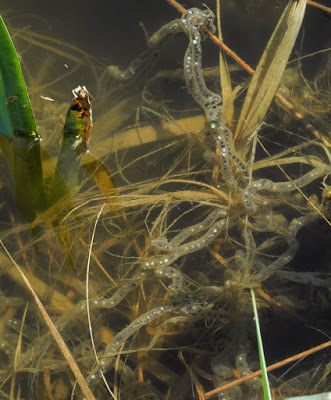As I walked around a familiar local hill farm yesterday, one with sweeping views of the surrounding landscape, I thought about how my eye has changed over the many years I've been going there. This photo, and all the others in this post are from yesterday's farm visit, and show different ways of seeing. Twenty years ago I may have wanted to paint an image like this, with agricultural architecture within a landscape....
Milking Time, Landaff, New Hampshire, 1991; oil on canvas, 32 x 110 in.
....a painting such as this, with the buildings and roads leading back in space. I often added figures for a narrative element.
Over time I became more interested in the stuff of farming, the ordinary things––machinery, plastics, structures such as silage bunkers and hoop barns––that were "ugly", and were evidence of the messy actuality of agriculture.
Blue Bucket, Barnet, Vermont, 1998; egg tempera on panel, 12 x 12 in.
So here I painted a battered plastic bucket, its color beautiful, meant as a warning for the culvert below. I painted this in the studio using a color study and black and white photos, as I did with all my work during these years. This scene was on the same farm that I photographed yesterday.
Irrigation Pipes, Barnet, Vermont, 2002; oil on canvas, 52 x 84 in.
At the time I loved the idea of contrasting the conventional beauty of the landscape with the industrial elements of modern farming. This view is across the valley from yesterday's farm, which can be seen on the hill in the distance at the left.
Then landscape began to recede in importance for me. Actually, I could no longer stand to do the work of painting all those distant trees, all that detail. I wanted to simplify the structure of my paintings.
Soon there was no landscape at all in the paintings, just the objects, seen almost as still life. I remember in the early 2000s, my gallery telling me that they could sell my work better if I put more landscape in it; I had to reply that it no longer had any landscape at all.
Black Tank (for Guston), 2005; egg tempera on panel, 27 x 32
Now it was just the things that excited me, even a fuel tank that I saw at this same farm, so different in subject and structure from Blue Bucket above. I painted some fairly complex, large compositions, along with smaller ones. So, I can do that kind of work, and I know a lot of people are disappointed that I don't still do it, especially the paintings with landscape. But we have to do what feels right to us, and what I have become most interested in is the tradition of twentieth century minimalist abstraction; I wanted to take what I knew and see it through that reductive lens. Those are the paintings that most excite me––paintings by, for instance, Mondrian, Malevich, Popova; and more recently Kelly, Heilmann, Mangold, Tantric painting––not twentieth century representational painting (although of course there are artists that I love who paint the visual world, such as Morandi and Sheeler). Hopper used to be an artist hero of mine; now it's Blinky Palermo.
So here is where I end up: a circle above an angled plane, cast shadows, and two small circles below. A representation, simplified, pared down to a few elements, which will change a bit when transformed into paint. It is not my job to judge my work, just to do the best that I think I can, while loving the process, which I do.




















































